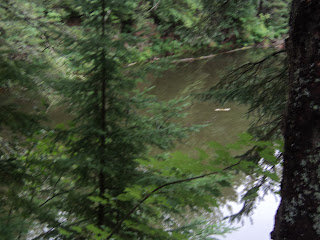Hike Location: Amnicon Falls State Park
Geographic Location: southeast ofSuperior , WI (46.61090, -91.89066)
Length: 1.7 miles
Geographic Location: southeast of
Length: 1.7 miles
Difficulty: 2/10 (Easy)
Date Hiked: August 2010
Overview: A short hike along the banks of the raging and fallingAmnicon River
Date Hiked: August 2010
Overview: A short hike along the banks of the raging and falling
Park Information: https://dnr.wisconsin.gov/topic/parks/amnicon
Directions to the trailhead: From Superior , head east on US 2. Where US 2 and US 53 split, angle left to continue east on US 2. Less than 1 mile past the split, turn left on CR U; there is a brown state park sign at this intersection. Take CR U 0.3 miles to the park entrance on the left, and turn left to enter the park. Take a sharp right at the Contact Station, heading for the waterfall area. At the Contact Station, you will need to pay the large park entrance fee; Wisconsin has the highest state park entrance fees of any state I am aware of. Take care crossing an old, narrow bridge on the park road. Park in the medium sized gravel parking lot for the waterfall area.
The hike: It was a mild, misty Monday morning when I drove through the gates at Amnicon Falls State Park Wisconsin . I had just completed a multi-day hiking trip on Minnesota ’s north shore, and I was trying to squeeze in one more hike before I began the long drive back to Georgia . Major waterfall parks such as this one have a tourist-trap reputation, but I had a very pleasant hike that morning.
The 825 acres comprising Amnicon Falls State Park Wisconsin was established in 1848, the state granted this land to the Chicago , St. Paul , Minneapolis and Omaha Railroad Company for the purpose of building a railroad to facilitate settlement. To defer construction costs, everything except for the right of way was sold, including the land around the river.
In the late 1800’s, lumberjacks came into the area; they used the rushing river to transport logs to mills downstream. In 1887, a quarry opened to exploit the area’s sandstone. The quarry would operate for nearly 20 years, and you can still see the remnants of this quarry on the Thimbleberry Trail described here.
In 1932, the river’s natural qualities were noticed, and Douglas County Bardon Park Wisconsin , and the state park was born.
The park’s rich industrial and parkland history are evident today in the old quarry and mature forest, respectively. The waterfalls are the main attraction, but some nice picnic areas make for great places to enjoy a meal under dense tree cover. Only two short trails traverse the grounds, but they lead to all major points of interest in the park. This hike will use both of these trails.
Before you leave the parking lot vicinity, there are three places you should visit. Located behind the men’s restroom building (a most unusual spot indeed) is Now and Then Falls, a small waterfall in the small creek you crossed on the narrow bridge on your drive in. The waterfalls here are created by the Douglas Fault, a line along which igneous basalt rock upstream was lifted above the reddish sandstone downstream. The Amnicon River
 |
| Now and Then Falls |
 |
| Upper Falls |
 |
| Lower Falls |
 |
| Snake Pit Falls |
The Thimbleberry Nature Trail begins by descending moderately, soon to arrive back at river level. Where the trail splits to form its loop, angle right to stay closer to the river. The trail heads downstream with the river rushing noisily to your right. Most people who visit this park never get past the waterfalls, and hence you will likely be alone on this trail.
The trail stays close to the river as it treads through lush, damp forest dominated by some large hemlock trees. Keep your eye out for the thimbleberry bush, identifiable by its bright red berries and large leaves, in the understory. At 0.6 miles, you climb a short set of wooden steps. These steps can be covered with a sheen of mud and hence will be very slippery when wet, so watch your step.
Just past the steps, the spur trail to the old sandstone quarry leads off to the right. An interpretive sign tells of the sandstone’s use; the rock was also called brownstone due to its dark red color. Only the rim of the quarry can be seen today, as the rest of the mine has filled with water. Some hemlock trees prevent a clear view of the resulting pond, but it is still easy to imagine what it must have been like to work here back in the late 1800’s.
 |
| Old sandstone quarry |
 |
| Approaching the covered bridge |
No comments:
Post a Comment